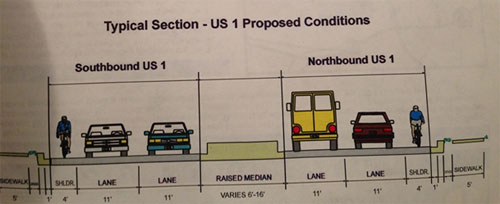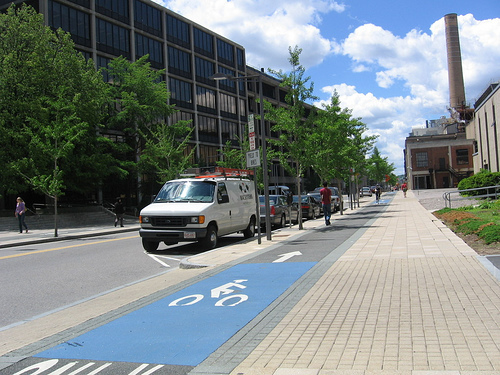Let’s build a great bike lane for Route 1 in College Park
March 2023 Update: On March 2, 2023, Patrick Wojahn was arrested and charged with possession and distribution of child exploitative material. While the situation is evolving, local press reports that he has admitted to the wrongdoing. GGWash shares in the anger and grief of many in our region upon learning that Wojahn could be capable of committing such egregious harm against children. We condemn his behavior in the strongest possible terms, will no longer maintain institutional ties to him, and affirm our commitment to fostering a safe, inclusive community. If you are seeking resources related to sexual abuse or violence, visit RAINN or contact RAINN’s National Sexual Assault Hotline at (800) 656-HOPE.
People who bicycle in College Park were very excited last year when Governor Martin O’Malley announced funding for bicycle and pedestrian improvements on Route 1 in College Park. But the state’s new plan for the road just includes basic, painted bicycle lanes. The road needs better bicycle infrastructure to be safe and attractive for cycling.

Rendering of SHA’s proposed typical section for Route 1 between College Ave and Greenbelt Road. Drawing by the author.
When the funding was announced last summer, one news report said that the plan called for a “bicycle and pedestrian trail along US 1 from College Avenue to MD-193.”
Northern Prince George’s county has an excellent bike trail system paralleling Route 1 and Metro’s Green Line, but many of the larger roads in the area are hostile to cyclists and pedestrians. Route 1 does not even have continuous sidewalks in many stretches between the University of Maryland and the beltway, and there are no protected bike lanes or cycletracks on any of the larger numbered state roads in the area.
The state’s design disappoints
Last week, the Maryland State Highway Administration (SHA) described a plan for section of Route 1 between College Ave. and Greenbelt Road that would create a narrow five-foot painted bike lane (four feet plus a one foot gutter pan) next to the curb.

A diagram from an SHA newsletter describing the proposed Route 1 cross-section.
Given the bus and delivery truck traffic on Route 1, a narrow bike lane could be hazardous, squeezing cyclists between an 8-inch concrete curb and large vehicles in dense traffic. In addition, buses that are stopped or idling by the curb would force cyclists into the roadway and mixed traffic — something neither cyclists nor drivers prefer. The SHA design is unlikely to be popular with either cyclists or drivers. College Park officials asked SHA hard questions about whether the design could include protected bike lanes, but SHA representatives didn’t have good answers beyond, essentially, “this is where we usually put bike lanes.” This design decision will make an enormous difference in the long run for College Park’s accessibility and business development. Since SHA will be rebuilding the entire roadway, this is once-in-a-generation opportunity for Prince George’s County. Will the bike lanes be part of an urban street design that is welcoming to pedestrians, bikes, and bus riders? Or will they lanes just be a stripe of paint between the curb and a roadway that is designed more like a suburban strip or rural highway? Why not a cycletrack? Fortunately, there are much better designs that cities nationwide have used for decades. Some even would allow for a narrower road, meaning Maryland would have to buy less land and do less of the expensive full-depth road reconstruction. Protected bike lanes, or cycletracks, physically separate between cyclists and vehicle traffic, offering a more comfortable and safer ride.

A protected lane through the MIT campus on Vassar Street, Cambridge, MA. Photo by straightedge217 on Flickr.
Twenty-four states use these lanes, which many cycle advocates call protected bike lanes and others call cycletracks. The District uses cycletracks extensively, and they have coincided with a boom in population and tax revenues for the city. A Route 1 with such a lane, keeping the same proposed center median, could look something like this:

Drawing by the author.
Cyclists do not have to compete with faster vehicles that can hit or kill them, nor do they have to compete with slower pedestrians on crowded sidewalks (like they do now). This is a win-win for all road users and dramatically improves everyone’s safe travel.
A two-way cycletrack might also be an option, especially on the west (University) side of Route 1.
Alternatively, SHA can also follow the lead of many other states by putting in buffered bike lanes. These separate the bike lanes from vehicle traffic within the road using striped or curbed buffers. While not as good as cycletracks or protected lanes, they are far superior to the simple painted lanes in SHA’s design.
Although there has limited space in the right-of-way on Route 1, SHA is working on expanding the right-of-way beyond its existing width. This gives College Park a rare opportunity to create enough space to safely accommodate cyclists and pedestrians.
Protected bike lanes will encourage bike commuting to the university and surrounding businesses and will take car traffic off the road. In order to entice people to bicycle, people need to feel safe. Basic painted bike lanes alone will not achieve that.
